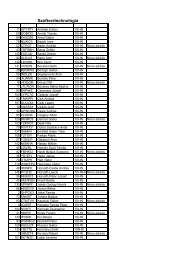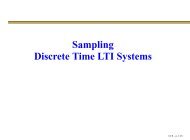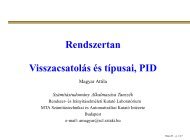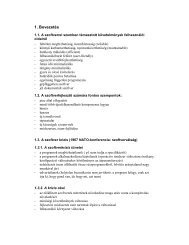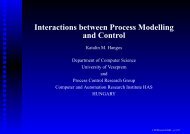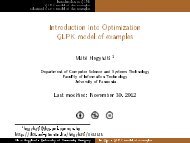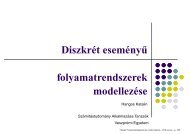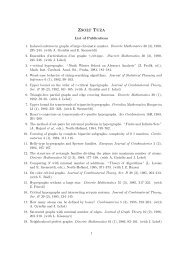Process integration, modelling and optimisation for energy saving ...
Process integration, modelling and optimisation for energy saving ...
Process integration, modelling and optimisation for energy saving ...
You also want an ePaper? Increase the reach of your titles
YUMPU automatically turns print PDFs into web optimized ePapers that Google loves.
F. Friedler / Applied Thermal Engineering 30 (2010) 2270e2280 2275<br />
consumption. A method <strong>for</strong> analysing <strong>energy</strong>, environmental, <strong>and</strong><br />
economic efficiency <strong>for</strong> an integrated steel plant was presented by<br />
Larsson et al. [119]. Global mathematical models <strong>for</strong> steel making<br />
processes have been developed with the help of PI techniques. The<br />
traditional beet sugar manufacturing technology has a considerable<br />
detrimental impact on the environment. Vaccari et al., [120] gave<br />
an overview of the environmental problems in beet sugar processing.<br />
They applied Water Pinch <strong>and</strong> Thermal Pinch Analyses to<br />
assist in finding ways to drastically reduce both water <strong>and</strong> <strong>energy</strong><br />
consumption. PI was applied to food industry. Kapustenko et al.<br />
[121] demonstrated the <strong>integration</strong> of a heat pump into the heat<br />
supply system of a cheese production plant in Ukraine. They analysed<br />
the opportunity of heat <strong>integration</strong> of an existing refrigeration<br />
unit into the process. A very interesting application of Heat<br />
Integration of evaporators with the remaining process has been<br />
presented by Axelsson et al. [122]. Their observation was that<br />
significant <strong>energy</strong> <strong>saving</strong>s can be made in the pulp <strong>and</strong> paper<br />
industry by implementing process integrated evaporation (termed<br />
“PIvap”). Using pinch tools they found a solution where 1.3 GJ/ADt<br />
(GJ per Air Dried t) of pinch violations were solved <strong>and</strong> 1.1 GJ/ADt of<br />
excess heat saved. Pulp-<strong>and</strong>-paper Kraft mills feature significant<br />
<strong>energy</strong> dem<strong>and</strong>s. Savulescu <strong>and</strong> Alva-Argáez [123] have proposed<br />
a PI methodology to systematically address direct heat transfer<br />
(DHT) aspects in the Kraft mill <strong>energy</strong> system retrofit context. Their<br />
observation shows that <strong>energy</strong>-efficient non-isothermal mixing<br />
points should be located at the end of a stream. From the process<br />
perspective, mixing should be below pinch or above to eliminate<br />
the inefficiencies, due to DHT cross-pinch. Additionally, mixers<br />
located away from the pinch represent degrees of freedom to<br />
design an optimal heat transfer network. Levasseur et al. [124] have<br />
presented an application of classical heat <strong>integration</strong> techniques<br />
with process changes to liquor evaporation in pulp-<strong>and</strong>-paper mill.<br />
The system involves multi-effect evaporation. The considered<br />
modifications were reduction of DT min , as well as variation of the<br />
pressures of evaporation effects. As a result, <strong>energy</strong> <strong>saving</strong>s of up to<br />
20% were reported. Accounting <strong>for</strong> the non-continuous operation of<br />
pulp-<strong>and</strong>-paper mills, Morrison et al. [125] presented a case study<br />
<strong>for</strong> varying paper grades. They applied the Time Slice Model <strong>for</strong><br />
batch heat <strong>integration</strong>. A powerful tool, Site-Model, was introduced<br />
by Hirata et al. [126]. To h<strong>and</strong>le the trade-off between the flexibility<br />
<strong>and</strong> the interactions, all units should be managed simultaneously.<br />
The tool implements a large-scale MILP model <strong>for</strong> the utility system<br />
<strong>optimisation</strong>. Nordgren et al. [127] presented heat balancing study<br />
of a metallurgical process with the aim to per<strong>for</strong>m a subsequent<br />
Heat Integration project. The paper is a part of a project which aim<br />
is to develop a PI model <strong>for</strong> the Swedish iron ore company LKAB’s<br />
production system in Malmberget. The authors analyse the various<br />
processing zones of the furnaces <strong>and</strong> the opportunities <strong>for</strong> heat<br />
recovery using external heat exchangers. Matsuda et al. [128]<br />
applied heat <strong>integration</strong> total site technology to a large industrial<br />
area in Japan to further improve per<strong>for</strong>mance of their already<br />
highly efficient process plants. Tovazhnyansky et al. [129]<br />
successfully completed process <strong>integration</strong> based synthesis of<br />
sodium hypophosphite production. Promvitak et al. [130] applied<br />
the heat <strong>integration</strong> methodology on the crude distillation unit.<br />
Varbanov <strong>and</strong> Friedler [131] boosted the <strong>energy</strong> convertion efficiency<br />
of fuel cell. Parisutkul et al. [132] improved the <strong>energy</strong><br />
efficiency of the natural gas separation plant. Atkins et al. [133]<br />
completed carbon emission pinch analysis of New Zeal<strong>and</strong> Electricity<br />
sector <strong>and</strong> Markowski et al. [134] fermentation based<br />
hydrogen plant connected with sugar factory. Varga et al. [135] by<br />
using heat <strong>integration</strong> improved <strong>energy</strong> efficiency of several units<br />
in MOL refineries in Hungary <strong>and</strong> Slovakia. Pavlas et al. [136]<br />
implemented the heat integrated heat pumping <strong>for</strong> biomass gasification<br />
processing.<br />
2. Optimisation <strong>for</strong> <strong>energy</strong> <strong>saving</strong>s <strong>and</strong> reduced emissions<br />
The field is enormously wide. There<strong>for</strong>e, this short overview is<br />
targeting <strong>optimisation</strong> methodologies which have the strongest<br />
impact on <strong>energy</strong> <strong>saving</strong> <strong>and</strong> pollution reduction.<br />
2.1. Integrated synthesis of process <strong>and</strong> HENs<br />
Nagy et al. [137] developed a new algorithmic method <strong>for</strong> the<br />
integrated synthesis of processes <strong>and</strong> HENs. Different methods<br />
exist <strong>for</strong> algorithmic process network synthesis (PNS) as well as <strong>for</strong><br />
heat exchanger-network synthesis, but they cannot easily be integrated.<br />
For instance, the flow rates of streams are not specified<br />
a priori in PNS; in contrast, the flow rates <strong>and</strong> temperatures of hot<br />
<strong>and</strong> cold streams have to be known as inputs in HEN synthesis<br />
(HENS). This difference can be attributed to the fact that the <strong>for</strong>mer<br />
is macroscopic in nature, while the latter is mesoscopic in nature,<br />
giving rise to the characteristic differences between them. Both PNS<br />
<strong>and</strong> HENS inevitably encounter combinatorial complexity, which is<br />
magnified profoundly when they are integrated, due to their<br />
interactions. The P-graph framework developed earlier <strong>for</strong> PNS<br />
[138] has been extended to the integrated synthesis of process <strong>and</strong><br />
heat exchanger networks. This new method resorts mainly to hPgraphs<br />
adapted from the P-graphs in conjunction with the appropriate<br />
selection of inherent intervals of temperature range. There<strong>for</strong>e,<br />
it focuses on the establishment of an appropriate technique <strong>for</strong><br />
the <strong>integration</strong> of PNS <strong>and</strong> HENS [137]. The resultant technique is<br />
largely based on combinatorial algorithms. The efficacy of the<br />
proposed approach was illustrated by the solution of an industrial<br />
problem.<br />
2.2. Scheduling in heat <strong>integration</strong> <strong>and</strong> water reuse <strong>for</strong> batch<br />
processes<br />
Foo et al. [73] present a two-stage procedure <strong>for</strong> the synthesis of<br />
a maximum water recovery network <strong>for</strong> a batch process system,<br />
covering both mass transfer-based <strong>and</strong> non-mass transfer-based<br />
water-using processes. Adonyi et al. [139] developed a new algorithmic<br />
method <strong>for</strong> heat <strong>integration</strong> of batch processes. By nature,<br />
batch process scheduling <strong>and</strong> heat <strong>integration</strong> are two significantly<br />
different highly complex <strong>optimisation</strong> problems. Many algorithmic<br />
<strong>and</strong> heuristic based methods exist <strong>for</strong> solving heat <strong>integration</strong><br />
problems by resorting to pinch technology; superstructure based<br />
mixed integer programming, <strong>and</strong> <strong>integration</strong> with process network<br />
synthesis. These methods have been developed <strong>for</strong> continuous<br />
processes where scheduling is of no concern. These two different<br />
problems can be solved sequentially, i.e., solving scheduling first<br />
<strong>and</strong> then heat <strong>integration</strong> or vice versa. Since the solution of one of<br />
them influences the other, the result of this simplistic approach is<br />
usually very poor. An integrated consideration of scheduling <strong>and</strong><br />
heat <strong>integration</strong> may provide appropriate solution. Since no<br />
method known up to that time <strong>for</strong> solving the integrated model, the<br />
development of a new method was desired <strong>for</strong> effective design <strong>and</strong><br />
operation of batch processes. The main issue was how to operate<br />
tasks with potential heat exchange simultaneously without sacrificing<br />
the quality of the scheduling solution. The proposed procedure<br />
is based on the branch-<strong>and</strong>-bound framework, where two<br />
<strong>optimisation</strong> problems, the scheduling <strong>and</strong> the heat <strong>integration</strong><br />
one, are considered simultaneously instead of consecutively.<br />
2.3. Batch scheduling with minimising cleaning costs<br />
The cleaning <strong>for</strong> batch processes, especially, paint production<br />
systems have been examined by Adonyi et al. [140]. Due to the<br />
large variety of options offered to customers, batch production



